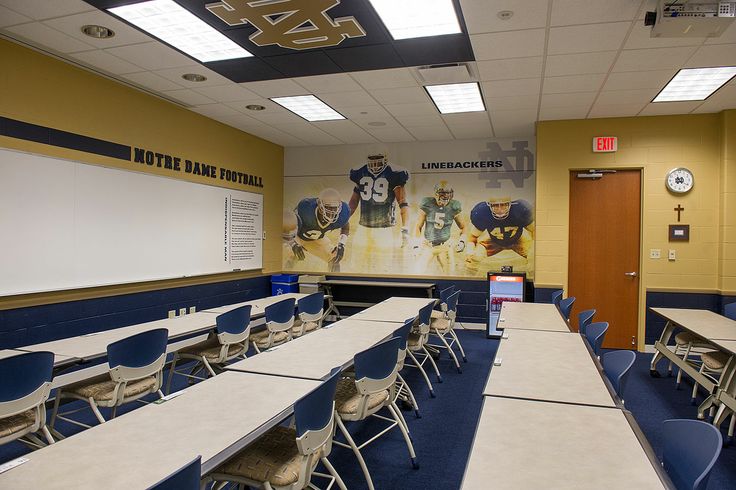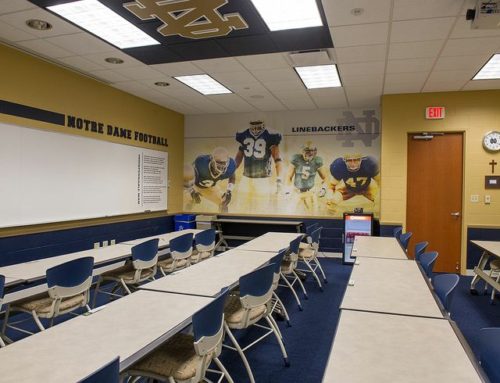Last season, for whatever reason, Notre Dame did not threaten the perimeter much in running plays. The biggest “stretch” of the outside, in my opinion, was probably the “give” option of power-read or inverted-veer that was ran a fair bit. Things will be different this season for the Irish.
Chip Long will be using a gap/zone family offspring run called the Pin & Pull to threaten the edge. This running play is kinda odd, it has down blocks and pulls, but it follows almost perfectly the rules from outside zone. Essentially, Pin & Pull is a “dynamic” run, in which virtually any linemen can be the puller or down-blocker depending on the defensive alignment. Pin & Pull is especially interesting because the linemen will be moving laterally which will allow more time to be given on RPO pass options before any technical football rules are violated.
With this stated, if you would, take a look at this read: This author does a fantastic job of breaking down the Pin & Pull, and I will draw from many of the explanations in this piece.
Now for everybody’s favorite section, the terminology section.
Terminology
Frontside: every blocker from the Center to playside (where the RB is going), could include TEs.
Backside: the opposite of frontside, every blocker besides the center, on the side of the line where the RB is not going.
Zone Rules: Lots of nuance, but basically, if you are covered, block that guy, and if you aren’t do something else (like in true-zone you would combo).
Down Block: I explained this in my G-scheme article, but essentially you block the first person toward the center in order to free up the puller.
How It’s Blocked
The Frontside follows “zone rules” to determine blockers and pullers. That means that if you are covered you Down block, and if you are uncovered you pull.
The Backside, similar to the G-scheme (this is a theme in Gap-runs) is sometimes blocked true zone, and sometimes follow frontside rules. Notre Dame seems to have frontside rules for the backside most of the time.
At the very front side of the play, there are very particular rules, due to a Down block not really being possible, I can’t do them justice, so read them here.
Puller rules can be complicated, but essentially they just block whoever they can find.
Film
Pin & Pull is generally called by who pulls, so if a center and guard pulls, it would be a CG or GC depending on which guard pulls.
The first clip is a GCT Pin & Pull. The pullers seemingly have the defense outflanked, but blocks were not held long enough for a nice gain.
The second clip is a GC Pull read. Wimbush will ideally read the Defensive End to ensure that he is wrong every time, but if you misread it, it is you that are wrong every time instead!
This is a GG Pin & Pull with the Frontside receiver setting up for a crack block, but Alex Bars wasn’t able to hold his block long enough.
This has a backside bubble screen attached, and is a TC Pin & Pull. As seems to be the theme of the B&G game for this play, if the blocks were a bit better, the RB would have had a nice gain at the edge.
Conclusion
Blocking on the Pin & Pull clearly needs to improve a bit from the B&G game. However, Notre Dame will likely use this play often to threaten the edges of the defense with as many men as the defensive formation allows. My light charting is here.



So, the G-scheme are inside runs, and the pin and pull are outside runs basically. They both use a pulling lineman/downhill run concept. Is that right DITB? And both of those schemes are old schoole concepts used in option football? I love it, thanks for the knowledge dude.
Thank you,
G-Scheme is also an outside run. Pin & Pull isn’t really used in option football, to my knowledge. Burger probably has a better answer to that. The rest of what you hit on is pretty correct.
Basically, the thing to look out for is currently doesn’t look like there is any “counter” play. I imagine that counter trey could come back because it was used so much last year. Long used a really odd play that I called a hb counter tackle long trap, but we haven’t seen it here. Long’s Inside Zone has an odd aiming point, so its almost like a built in zone counter every snap.